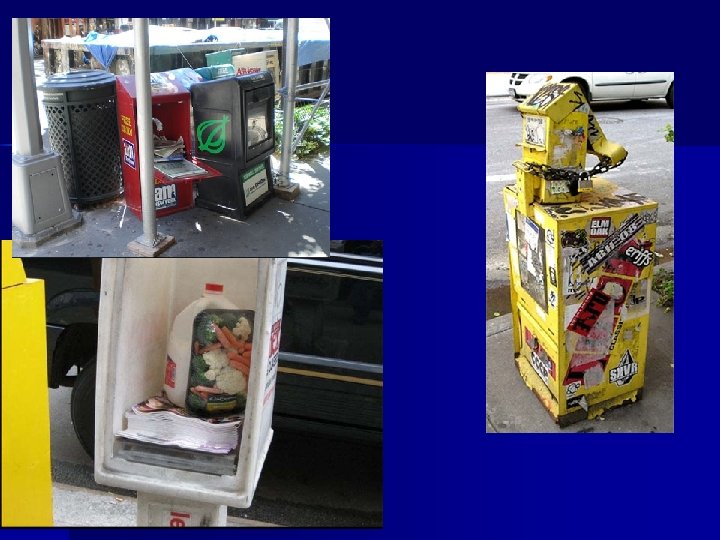fbe0644de074248a1522894e57cb7844.ppt
- Количество слайдов: 98
 ZONING – SPECIFIC APPLICATIONS Aesthetic and Signs & Some Art
ZONING – SPECIFIC APPLICATIONS Aesthetic and Signs & Some Art
 Communication as Education
Communication as Education
 A Stroll Through the Town
A Stroll Through the Town
 Regulation and Beauty
Regulation and Beauty
 Reasons For Aesthetic Regulation n Theories of Regulation – – – Aesthetic Harms Environmental Benefit Economic Harms (property values) Safety – impairment of driving Historicity and Historic Preservation
Reasons For Aesthetic Regulation n Theories of Regulation – – – Aesthetic Harms Environmental Benefit Economic Harms (property values) Safety – impairment of driving Historicity and Historic Preservation
 Aesthetic Harms?
Aesthetic Harms?
 Freedom to Choose, Or Bound to Lose?
Freedom to Choose, Or Bound to Lose?
 Economic Harms?
Economic Harms?
 And the Art Argument
And the Art Argument
 Berman v Parker n n n Prior to Berman v Parker beauty and aesthetics was not considered a valid exercise of the police power in most states Beauty, it was said, lies in the eyes of the beholder and is not an objective standard equal to health, safety and welfare The one exception to this rule is that historic preservation and design had long been accorded some weight in land use decisions
Berman v Parker n n n Prior to Berman v Parker beauty and aesthetics was not considered a valid exercise of the police power in most states Beauty, it was said, lies in the eyes of the beholder and is not an objective standard equal to health, safety and welfare The one exception to this rule is that historic preservation and design had long been accorded some weight in land use decisions
 The Washington D. C. Slums
The Washington D. C. Slums
 Background to Berman n n n The District of Columbia Redevelopment Act allows the National Capital Planning Commission to prepare plans and designate land for redevelopment The first redevelopment took place in Southwest Washington D. C. in Area B 65% of the dwellings were beyond repair 57% had no inside toilets 82% had no wash basins 17% of the units were in satisfactory condition P. S. – 97% of the residents were African-American
Background to Berman n n n The District of Columbia Redevelopment Act allows the National Capital Planning Commission to prepare plans and designate land for redevelopment The first redevelopment took place in Southwest Washington D. C. in Area B 65% of the dwellings were beyond repair 57% had no inside toilets 82% had no wash basins 17% of the units were in satisfactory condition P. S. – 97% of the residents were African-American
 Berman’s Argument n n Berman owned a department store building in the redevelopment area It is commercial – not residential The building is in satisfactory shape and since it is not a “slum” it cannot be taken To take property for the clearance of slums is one thing – but to take property just to build and more balanced, more attractive community is unconstitutional
Berman’s Argument n n Berman owned a department store building in the redevelopment area It is commercial – not residential The building is in satisfactory shape and since it is not a “slum” it cannot be taken To take property for the clearance of slums is one thing – but to take property just to build and more balanced, more attractive community is unconstitutional
 Supreme Court n n n Public safety, public health, quiet, land order – these are some of the conspicuous examples of the traditional application of the police power by government Yet, these examples merely illustrates the range of the power police and do not delimit it The concept of the public welfare is broad and inclusive
Supreme Court n n n Public safety, public health, quiet, land order – these are some of the conspicuous examples of the traditional application of the police power by government Yet, these examples merely illustrates the range of the power police and do not delimit it The concept of the public welfare is broad and inclusive
 Decision n It was important to redevelop the entire area – not to just to pick slum buildings It was important to redesign the whole area so as to eliminate the conditions that cause slums – the over-crowding of dwellings, the lack of parks, the lack of adequate streets and alleys, the absence of recreational areas, the lack of light and air The values it represents are spiritual as well as physical, aesthetic as well as monetary. It is within the power of the legislature to determine that the community should be beautiful as well as healthy, spacious as well as clean, wellbalanced as well as carefully patrolled.
Decision n It was important to redevelop the entire area – not to just to pick slum buildings It was important to redesign the whole area so as to eliminate the conditions that cause slums – the over-crowding of dwellings, the lack of parks, the lack of adequate streets and alleys, the absence of recreational areas, the lack of light and air The values it represents are spiritual as well as physical, aesthetic as well as monetary. It is within the power of the legislature to determine that the community should be beautiful as well as healthy, spacious as well as clean, wellbalanced as well as carefully patrolled.
 Today’s Picks
Today’s Picks
 City Nichols Hill v Peggy Richardson
City Nichols Hill v Peggy Richardson
 Background n Peggy Richardson was cited on March 22, 1992, for violating a City of Nichols Hills (City) ordinance by parking her pickup in the driveway of her Nichols Hills home between the hours of 2: 00 and 5: 00 a. m n She was fined $100. 00 and the judge suspended the fine n She asked for a variance from this ordinance on the basis the pickup was her only vehicle but was denied n She challenged the ordinance in district court and the judge found the ordinance unconstitutional on its face as arbitrary, capricious, and unreasonable
Background n Peggy Richardson was cited on March 22, 1992, for violating a City of Nichols Hills (City) ordinance by parking her pickup in the driveway of her Nichols Hills home between the hours of 2: 00 and 5: 00 a. m n She was fined $100. 00 and the judge suspended the fine n She asked for a variance from this ordinance on the basis the pickup was her only vehicle but was denied n She challenged the ordinance in district court and the judge found the ordinance unconstitutional on its face as arbitrary, capricious, and unreasonable
 Facts Her profession and livelihood as a horse trainer necessitate her ownership and use of a pickup and her economic circumstances are such that she cannot afford to purchase a separate 'town car' to park in her driveway, just so she can comply with the ordinance. Her pickup is used for both personal and business purposes; it is not tagged as a commercial vehicle and displays no commercial vehicle markings or signs.
Facts Her profession and livelihood as a horse trainer necessitate her ownership and use of a pickup and her economic circumstances are such that she cannot afford to purchase a separate 'town car' to park in her driveway, just so she can comply with the ordinance. Her pickup is used for both personal and business purposes; it is not tagged as a commercial vehicle and displays no commercial vehicle markings or signs.
 The Ordinance It shall be unlawful to park any commercial vehicle, recreational vehicle, trailer, taxi-cab or mobile home or any vehicle of any kind except a private passenger vehicle on private property located within the U-1 use district, between the hours of 2: 00 a. m. and 5: 00 a. m. , unless such vehicle is parked on a permanently hard surfaced area or driveway completely to the rear of the front wall of the main building located on the property, and unless such vehicle shall be screened from view from the main and any side street upon which the property abuts.
The Ordinance It shall be unlawful to park any commercial vehicle, recreational vehicle, trailer, taxi-cab or mobile home or any vehicle of any kind except a private passenger vehicle on private property located within the U-1 use district, between the hours of 2: 00 a. m. and 5: 00 a. m. , unless such vehicle is parked on a permanently hard surfaced area or driveway completely to the rear of the front wall of the main building located on the property, and unless such vehicle shall be screened from view from the main and any side street upon which the property abuts.
 Appeals Court • • • The governmental power to interfere by zoning regulations with the general rights of the land owner by restricting the character of its use is not unlimited and such restriction cannot be imposed if it does not bear a substantial relationship to the public health, safety, morals or general welfare. Any vehicle that meets the definition of a "private passenger vehicle" - no matter how ugly, rusted or offensive, may be parked in this municipality between the hours of 2: 00 a. m. and 5: 00 a. m. However, not a single pickup - no matter how new, expensive, or "pleasing to the eye", may be parked in any driveway during these hours
Appeals Court • • • The governmental power to interfere by zoning regulations with the general rights of the land owner by restricting the character of its use is not unlimited and such restriction cannot be imposed if it does not bear a substantial relationship to the public health, safety, morals or general welfare. Any vehicle that meets the definition of a "private passenger vehicle" - no matter how ugly, rusted or offensive, may be parked in this municipality between the hours of 2: 00 a. m. and 5: 00 a. m. However, not a single pickup - no matter how new, expensive, or "pleasing to the eye", may be parked in any driveway during these hours
 Decision n • • During the hours from 2: 00 a. m. to 5: 00 a. m. , persons that could be offended by the sight of a pickup, cannot see a pickup, or any other vehicle for that matter, as it is normally dark during these hours However, these same people can see an operational rusted-out jalopy, classified as a "private passenger vehicle", parked in any driveway during the daylight hours. We cannot distinguish how one vehicle could negatively affect property values and the other could not
Decision n • • During the hours from 2: 00 a. m. to 5: 00 a. m. , persons that could be offended by the sight of a pickup, cannot see a pickup, or any other vehicle for that matter, as it is normally dark during these hours However, these same people can see an operational rusted-out jalopy, classified as a "private passenger vehicle", parked in any driveway during the daylight hours. We cannot distinguish how one vehicle could negatively affect property values and the other could not
 The Outcome n However, we find this ordinance, does not promote aesthetics as alleged This is not OK This is OK
The Outcome n However, we find this ordinance, does not promote aesthetics as alleged This is not OK This is OK
 Stoyanoff v Berkeley A suburban or Colonial, French Provincial or English Tudor Homes - Architectural Review Board – Ugly House? Hint – This is not English Tudor
Stoyanoff v Berkeley A suburban or Colonial, French Provincial or English Tudor Homes - Architectural Review Board – Ugly House? Hint – This is not English Tudor
 This Really Is English Tudor
This Really Is English Tudor
 A Matter of Taste?
A Matter of Taste?
 Even Rednecks Have Taste
Even Rednecks Have Taste
 Or Just Plain Butt Ugly?
Or Just Plain Butt Ugly?
 The Background n n Ladue establishes an architectural review board for all structures Buildings must “conform to certain minimum architectural standards of appearance and conformity with surrounding structures, and that unsightly, grotesque and unsuitable structures, detrimental to the stability of value and the welfare of surrounding property, structures and residents, and to the general welfare and happiness of the community, be avoided, and that appropriate standards of beauty and conformity be fostered and encouraged. "
The Background n n Ladue establishes an architectural review board for all structures Buildings must “conform to certain minimum architectural standards of appearance and conformity with surrounding structures, and that unsightly, grotesque and unsuitable structures, detrimental to the stability of value and the welfare of surrounding property, structures and residents, and to the general welfare and happiness of the community, be avoided, and that appropriate standards of beauty and conformity be fostered and encouraged. "
 Unusual Appearance?
Unusual Appearance?
 Situation n n Plaintiffs purchase a lot in a neighborhood filled with Tutor and French Provincial design homes They seek to have an ultra modern house approved
Situation n n Plaintiffs purchase a lot in a neighborhood filled with Tutor and French Provincial design homes They seek to have an ultra modern house approved
 Actually, This Is A Similar Model Of the Home
Actually, This Is A Similar Model Of the Home
 Inside, Rear View
Inside, Rear View
 Findings n The intrusion into this neighborhood of this unusual, grotesque and nonconforming structure would have a substantial adverse effect on market values of other homes in the immediate area.
Findings n The intrusion into this neighborhood of this unusual, grotesque and nonconforming structure would have a substantial adverse effect on market values of other homes in the immediate area.
 Opposition Fires Back n n There exists no provision providing for an architectural board and no entity even remotely resembling such a board is mentioned under the enabling legislation in Missouri Can’t deny a building permit just because it looks different
Opposition Fires Back n n There exists no provision providing for an architectural board and no entity even remotely resembling such a board is mentioned under the enabling legislation in Missouri Can’t deny a building permit just because it looks different
 Court Notes n n This residential suburb is composed primarily of high end Cottage, Tutor, Provincial, and traditional housing The stabilizing of property values, and giving some assurance to the public that, if property is purchased in a residential district, its value as such will be preserved, is probably the most cogent reason back of this zoning ordinance
Court Notes n n This residential suburb is composed primarily of high end Cottage, Tutor, Provincial, and traditional housing The stabilizing of property values, and giving some assurance to the public that, if property is purchased in a residential district, its value as such will be preserved, is probably the most cogent reason back of this zoning ordinance
 Finding n n n The aesthetic factor to be taken into account by the Architectural Board is not to be considered alone. Along with that inherent factor is the effect that the proposed residence would have upon the property values in the area In this time of burgeoning urban areas, congested with people and structures, it is certainly in keeping with the ultimate ideal of general welfare that the Architectural Board, in its function, preserve and protect existing areas in which structures of a general conformity of architecture have been erected.
Finding n n n The aesthetic factor to be taken into account by the Architectural Board is not to be considered alone. Along with that inherent factor is the effect that the proposed residence would have upon the property values in the area In this time of burgeoning urban areas, congested with people and structures, it is certainly in keeping with the ultimate ideal of general welfare that the Architectural Board, in its function, preserve and protect existing areas in which structures of a general conformity of architecture have been erected.
 Conclusion n n Architectural review does not vest standard less powers in a review board General standards are sufficient for determining whether the proposed building would or would not promote the "health, safety, morals or general welfare of the community" or would not adversely affect "the character of the neighborhood, traffic conditions, public utility facilities and other matters pertaining to the general welfare
Conclusion n n Architectural review does not vest standard less powers in a review board General standards are sufficient for determining whether the proposed building would or would not promote the "health, safety, morals or general welfare of the community" or would not adversely affect "the character of the neighborhood, traffic conditions, public utility facilities and other matters pertaining to the general welfare
 The – “What? No Trailers Case!” Livingston Township v Marchev, N. J. 1964
The – “What? No Trailers Case!” Livingston Township v Marchev, N. J. 1964
 The Local Scene n n n The Marchevs reside in a single family home in Livingston N. J They purchase a camping/travel trailer. It is about 7’ long and 6’ wide When they were not using their trailer, they park it near their house The local ordinance - It shall be unlawful for any person to park any trailer or camp car on any street in the Township of Livingston or on any premises within the limits of the Township except for the purpose of repair or storage. Any such trailer or camp car undergoing repairs or being stored shall be kept within a building and shall not during such period of repairs or storage be used by person as a dwelling or sleeping place. "
The Local Scene n n n The Marchevs reside in a single family home in Livingston N. J They purchase a camping/travel trailer. It is about 7’ long and 6’ wide When they were not using their trailer, they park it near their house The local ordinance - It shall be unlawful for any person to park any trailer or camp car on any street in the Township of Livingston or on any premises within the limits of the Township except for the purpose of repair or storage. Any such trailer or camp car undergoing repairs or being stored shall be kept within a building and shall not during such period of repairs or storage be used by person as a dwelling or sleeping place. "
 The Trailer In Question
The Trailer In Question
 Claim and Counter Claim n n The Marchevs maintain that the parking of a camp trailer adjacent to their home involved a permissible right incident to a family hobby or recreational activity and therefore it was a valid accessory use. The maintenance of a family home includes uses for private, educational, cultural and recreational activities. Also, that the pursuit of a hobby is customarily a part of recreational activity.
Claim and Counter Claim n n The Marchevs maintain that the parking of a camp trailer adjacent to their home involved a permissible right incident to a family hobby or recreational activity and therefore it was a valid accessory use. The maintenance of a family home includes uses for private, educational, cultural and recreational activities. Also, that the pursuit of a hobby is customarily a part of recreational activity.
 Court Concludes n The ordinance under review is aimed at preventing unsightly appearances and diminution of property values which attend the outdoor parking or open-air storage of trailers in a residential area of the community n The reasonableness of the prohibitory enactment is evidenced by the provision which permits the storing of trailers "within a building. " Defendants were not deprived of a right to own a trailer or to store it on their premises; they were only restricted from indulging in a use that would impinge upon the rights of other property owners n The ordinance is constitutional
Court Concludes n The ordinance under review is aimed at preventing unsightly appearances and diminution of property values which attend the outdoor parking or open-air storage of trailers in a residential area of the community n The reasonableness of the prohibitory enactment is evidenced by the provision which permits the storing of trailers "within a building. " Defendants were not deprived of a right to own a trailer or to store it on their premises; they were only restricted from indulging in a use that would impinge upon the rights of other property owners n The ordinance is constitutional
 Figarsky v Historic District Commission - 1976
Figarsky v Historic District Commission - 1976
 Basics n n The Figariski are owners of a house and lot located within the Norwich historic district One hundred buildings and lots surrounding, or in close proximity to, the green.
Basics n n The Figariski are owners of a house and lot located within the Norwich historic district One hundred buildings and lots surrounding, or in close proximity to, the green.
 Location n n Figarsky owns a two-story building zoned for commercial uses and is located just inside the bounds of the district. The property faces the green but is bounded on two sides by a Mickey Dees’ hamburger stand parking lot. The Rose of New England
Location n n Figarsky owns a two-story building zoned for commercial uses and is located just inside the bounds of the district. The property faces the green but is bounded on two sides by a Mickey Dees’ hamburger stand parking lot. The Rose of New England
 Mickey Ds London
Mickey Ds London
 Controversy n n The building is in need of some repairs, which the Norwich building inspector has ordered the plaintiffs to undertake. Rather than make the repairs, however, the plaintiffs would prefer to demolish the building.
Controversy n n The building is in need of some repairs, which the Norwich building inspector has ordered the plaintiffs to undertake. Rather than make the repairs, however, the plaintiffs would prefer to demolish the building.
 The Hearing n n The defendant held a public hearing on the application on January 25, 1973. The hearing was attended by more than 100 persons, none of whom, except for the plaintiffs and their attorney, spoke in favor of granting the application. On the following day, the commission voted unanimously to deny the plaintiffs' application.
The Hearing n n The defendant held a public hearing on the application on January 25, 1973. The hearing was attended by more than 100 persons, none of whom, except for the plaintiffs and their attorney, spoke in favor of granting the application. On the following day, the commission voted unanimously to deny the plaintiffs' application.
 Round Two n n n Figarsky files in district court They maintain that the costs of the repairs necessary for the building are prohibitive. The building inspector has ordered the plaintiffs to repair the foundation and replace a door sill and hall floor, and the health department has ordered the plaintiffs to tie in to a newly accessible public sewer. The Figarskys offered the testimony of a local contractor to the effect that the cost of these repairs, together with the cost of reroofing the building, would amount to between $ 15, 000 and $ 18, 000. They lose the case.
Round Two n n n Figarsky files in district court They maintain that the costs of the repairs necessary for the building are prohibitive. The building inspector has ordered the plaintiffs to repair the foundation and replace a door sill and hall floor, and the health department has ordered the plaintiffs to tie in to a newly accessible public sewer. The Figarskys offered the testimony of a local contractor to the effect that the cost of these repairs, together with the cost of reroofing the building, would amount to between $ 15, 000 and $ 18, 000. They lose the case.
 On Appeal n In their appeal, the plaintiffs allege that they will be forced to undergo economic hardship and loss as a result of not being permitted to demolish their building, and that the historic district commission, in denying their application for a certificate of appropriateness, acted illegally, arbitrarily and in abuse of its discretion.
On Appeal n In their appeal, the plaintiffs allege that they will be forced to undergo economic hardship and loss as a result of not being permitted to demolish their building, and that the historic district commission, in denying their application for a certificate of appropriateness, acted illegally, arbitrarily and in abuse of its discretion.
 The Key Question n n Although the Figarskys recognize the right and the power of the Historic Commission to regulate the building of new structures, or renovate existing buildings, they do not have the power to prevent the lawful removal of an existing building in the district. This is "vague aesthetic legislation, " incapable of application in accordance with mandates of due process
The Key Question n n Although the Figarskys recognize the right and the power of the Historic Commission to regulate the building of new structures, or renovate existing buildings, they do not have the power to prevent the lawful removal of an existing building in the district. This is "vague aesthetic legislation, " incapable of application in accordance with mandates of due process
 Three Strikes – You’re Out n The plaintiffs went no further than to present evidence that their house was unoccupied and in need of extensive repairs. There was no evidence offered that the house, if repaired, would not be of some value, or that the proximity of the Mc. Donald's hamburger stand rendered the property of practically no value as a part of the historic district.
Three Strikes – You’re Out n The plaintiffs went no further than to present evidence that their house was unoccupied and in need of extensive repairs. There was no evidence offered that the house, if repaired, would not be of some value, or that the proximity of the Mc. Donald's hamburger stand rendered the property of practically no value as a part of the historic district.
 What Can Be Done In A Case Like This n n n Obtain certificate of necessity to show why the building is of only marginal historic value Demonstrate that the building is in a state of structural decay that would prohibit a profitable use if rehabilitated Yadda yadda
What Can Be Done In A Case Like This n n n Obtain certificate of necessity to show why the building is of only marginal historic value Demonstrate that the building is in a state of structural decay that would prohibit a profitable use if rehabilitated Yadda yadda
 But, Take Note – Some Historic Icons Are Highly Controversial
But, Take Note – Some Historic Icons Are Highly Controversial
 Metromedia v San Diego n n A San Diego ordinance permits onsite commercial advertising (a sign advertising goods or services available on the property where the sign is located), but forbids other commercial advertising and noncommercial advertising using fixed-structure signs, Unless permitted by 1 of the ordinance's 12 specified exceptions, such as – temporary political campaign signs n Appellants, companies that were engaged in the outdoor advertising business in the city when the ordinance was passed, brought suit in state court to enjoin enforcement of the ordinance.
Metromedia v San Diego n n A San Diego ordinance permits onsite commercial advertising (a sign advertising goods or services available on the property where the sign is located), but forbids other commercial advertising and noncommercial advertising using fixed-structure signs, Unless permitted by 1 of the ordinance's 12 specified exceptions, such as – temporary political campaign signs n Appellants, companies that were engaged in the outdoor advertising business in the city when the ordinance was passed, brought suit in state court to enjoin enforcement of the ordinance.
 Through the Courts n n Trail court holds the ordinance invalid as over inclusive Appeal Court affirms CA Supreme Course Reverses U. S. Supreme Court Takes the Case
Through the Courts n n Trail court holds the ordinance invalid as over inclusive Appeal Court affirms CA Supreme Course Reverses U. S. Supreme Court Takes the Case
 1 st Line of Reasoning n n n Insofar as it regulates commercial speech, the ordinance meets the constitutional requirements of Central Hudson Improving traffic safety and the appearance of the city are substantial governmental goals. The ordinance directly serves these goals and is no broader than necessary to accomplish such ends
1 st Line of Reasoning n n n Insofar as it regulates commercial speech, the ordinance meets the constitutional requirements of Central Hudson Improving traffic safety and the appearance of the city are substantial governmental goals. The ordinance directly serves these goals and is no broader than necessary to accomplish such ends
 However n However, the city's general ban on signs carrying noncommercial advertising is invalid under the First and Fourteenth Amendments. – The fact that the city may value commercial messages relating to onsite goods and services more than it values commercial communications relating to offsite goods and services does not justify prohibiting an occupant from displaying his own ideas or those of others. n Furthermore, because under the ordinance's specified exceptions some noncommercial messages may be conveyed on billboards throughout the commercial and industrial zones, the city must allow billboards conveying other noncommercial messages throughout those zones. The ordinance cannot be characterized as a reasonable "time, place, and manner" restriction.
However n However, the city's general ban on signs carrying noncommercial advertising is invalid under the First and Fourteenth Amendments. – The fact that the city may value commercial messages relating to onsite goods and services more than it values commercial communications relating to offsite goods and services does not justify prohibiting an occupant from displaying his own ideas or those of others. n Furthermore, because under the ordinance's specified exceptions some noncommercial messages may be conveyed on billboards throughout the commercial and industrial zones, the city must allow billboards conveying other noncommercial messages throughout those zones. The ordinance cannot be characterized as a reasonable "time, place, and manner" restriction.
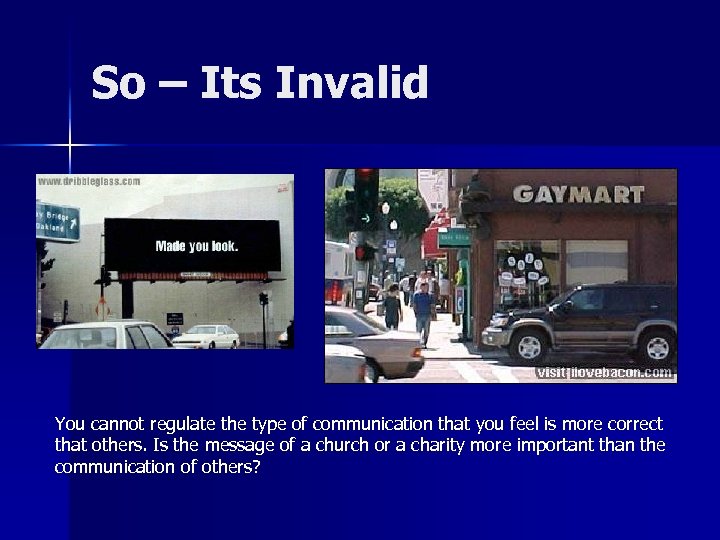 So – Its Invalid You cannot regulate the type of communication that you feel is more correct that others. Is the message of a church or a charity more important than the communication of others?
So – Its Invalid You cannot regulate the type of communication that you feel is more correct that others. Is the message of a church or a charity more important than the communication of others?
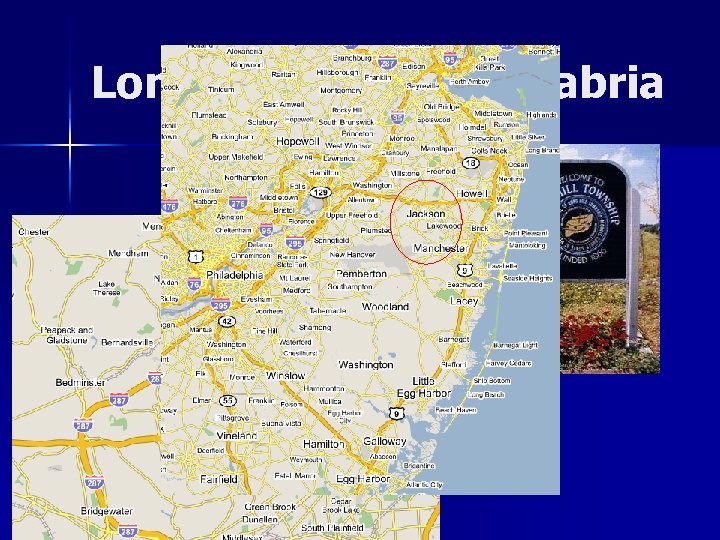 Long Hill Twsp. V Calabria
Long Hill Twsp. V Calabria
 Controversy – Lights? n. In 1997 Calabrai & Gillette Liquors & Diane’s Country Kitchen were charged with a violation of the sign control section of the Township's zoning ordinance. n. The ordinance required that all illuminated signs have an external light source. Direct lighting of signs is prohibited
Controversy – Lights? n. In 1997 Calabrai & Gillette Liquors & Diane’s Country Kitchen were charged with a violation of the sign control section of the Township's zoning ordinance. n. The ordinance required that all illuminated signs have an external light source. Direct lighting of signs is prohibited
 Who Had What? n n n Calabria II had two green neon "open" signs in script illuminated during business hours. Diane's Country Kitchen had two neon "open" signs and three white neon signs stating "deli“ "catering" and "subs. “ Gillette Liquors had six neon signs advertising different beers and one neon "open" sign.
Who Had What? n n n Calabria II had two green neon "open" signs in script illuminated during business hours. Diane's Country Kitchen had two neon "open" signs and three white neon signs stating "deli“ "catering" and "subs. “ Gillette Liquors had six neon signs advertising different beers and one neon "open" sign.
 Example
Example
 Reasoning n Specifically, the issues are whether the restrictions – are justified without reference to content; – whether the restrictions serve a significant government interest; – And whether the restrictions leave open ample alternative channels for communication of the information. The court found no intent or effect of the ordinance to regulate content and found that it was a legitimate
Reasoning n Specifically, the issues are whether the restrictions – are justified without reference to content; – whether the restrictions serve a significant government interest; – And whether the restrictions leave open ample alternative channels for communication of the information. The court found no intent or effect of the ordinance to regulate content and found that it was a legitimate
 Remaining Issues n Does the regulation serve a significant governmental interest? – Courts have acknowledged that advancement of a town's aesthetic interests is a valid justification for regulation of commercial activity – A town can act to regulate lighting, or to restrict size and number of signs or structures – Such aesthetic judgments are necessarily subjective and must be carefully scrutinized to determine if they are only a public rationalization of an impermissible purpose – If there is no ulterior motive for the suppression of a certain form of speech, the court cannot reject a legislative judgment.
Remaining Issues n Does the regulation serve a significant governmental interest? – Courts have acknowledged that advancement of a town's aesthetic interests is a valid justification for regulation of commercial activity – A town can act to regulate lighting, or to restrict size and number of signs or structures – Such aesthetic judgments are necessarily subjective and must be carefully scrutinized to determine if they are only a public rationalization of an impermissible purpose – If there is no ulterior motive for the suppression of a certain form of speech, the court cannot reject a legislative judgment.
 Well Does It? n n The record is devoid of evidence, facts or analysis why the mere existence of neon is offensive to the town’s goal of beautification There is no evidence that there are unusual problems in the use of neon that cannot otherwise be regulated as other forms of lighting, specifically, – As to degree of illumination; – Amount of light used within a given space or size of structure; – Direction of the light; – Times when the light may be used; – Or number of lights used on the interior of the store.
Well Does It? n n The record is devoid of evidence, facts or analysis why the mere existence of neon is offensive to the town’s goal of beautification There is no evidence that there are unusual problems in the use of neon that cannot otherwise be regulated as other forms of lighting, specifically, – As to degree of illumination; – Amount of light used within a given space or size of structure; – Direction of the light; – Times when the light may be used; – Or number of lights used on the interior of the store.
 Conclusion n n The Township failed to show that a municipalwide ban on neon "serves a significant government interest. " The record is devoid of evidence that establishes that neon in and of itself - without other less restrictive methods to regulate its use, such as through size, degree of illumination or brightness, or number - improperly contributes to the unwanted "highway“ commercial look.
Conclusion n n The Township failed to show that a municipalwide ban on neon "serves a significant government interest. " The record is devoid of evidence that establishes that neon in and of itself - without other less restrictive methods to regulate its use, such as through size, degree of illumination or brightness, or number - improperly contributes to the unwanted "highway“ commercial look.
 Georgia Manufactures Assoc. v Spalding - 1997 n n Spalding County, Georgia (County), amended its Zoning Ordinance to require that manufactured homes be built with a 4: 12 roof pitch to qualify for placement in most residential districts The district court struck down the 4: 12 requirement, holding that the 4: 12 requirement violates equal protection, substantive due process, and the dormant Commerce Clause and that the 4: 12 requirement is preempted by federal law.
Georgia Manufactures Assoc. v Spalding - 1997 n n Spalding County, Georgia (County), amended its Zoning Ordinance to require that manufactured homes be built with a 4: 12 roof pitch to qualify for placement in most residential districts The district court struck down the 4: 12 requirement, holding that the 4: 12 requirement violates equal protection, substantive due process, and the dormant Commerce Clause and that the 4: 12 requirement is preempted by federal law.
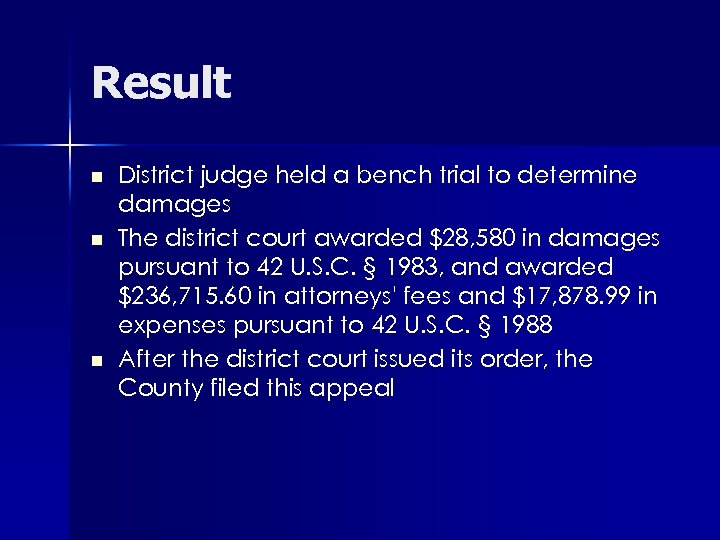 Result n n n District judge held a bench trial to determine damages The district court awarded $28, 580 in damages pursuant to 42 U. S. C. § 1983, and awarded $236, 715. 60 in attorneys' fees and $17, 878. 99 in expenses pursuant to 42 U. S. C. § 1988 After the district court issued its order, the County filed this appeal
Result n n n District judge held a bench trial to determine damages The district court awarded $28, 580 in damages pursuant to 42 U. S. C. § 1983, and awarded $236, 715. 60 in attorneys' fees and $17, 878. 99 in expenses pursuant to 42 U. S. C. § 1988 After the district court issued its order, the County filed this appeal
 Appeals Court n Applies the rational basis test to the requirement – Determine if there is a legitimate government purpose-a goal-which the enacting government body could have been pursuing. The actual motivations of the enacting governmental body are entirely irrelevant. . – The next inquiry is concerned with the existence of a conceivably rational basis, not whether that basis was actually considered by the legislative body. As long as reasons for the legislative classification may have been considered to be true, and the relationship between the classification and the goal is not so attenuated as to render the distinction arbitrary or irrational, the legislation survives rational-basis scrutiny
Appeals Court n Applies the rational basis test to the requirement – Determine if there is a legitimate government purpose-a goal-which the enacting government body could have been pursuing. The actual motivations of the enacting governmental body are entirely irrelevant. . – The next inquiry is concerned with the existence of a conceivably rational basis, not whether that basis was actually considered by the legislative body. As long as reasons for the legislative classification may have been considered to be true, and the relationship between the classification and the goal is not so attenuated as to render the distinction arbitrary or irrational, the legislation survives rational-basis scrutiny
 And. … n County could have been pursuing the goal of "aesthetic compatibility, " seeking to reduce friction between the appearance of site-built homes and manufactured homes by requiring manufactured homes to conform with standard characteristics of site-built homes, such as roof pitch and foundation
And. … n County could have been pursuing the goal of "aesthetic compatibility, " seeking to reduce friction between the appearance of site-built homes and manufactured homes by requiring manufactured homes to conform with standard characteristics of site-built homes, such as roof pitch and foundation
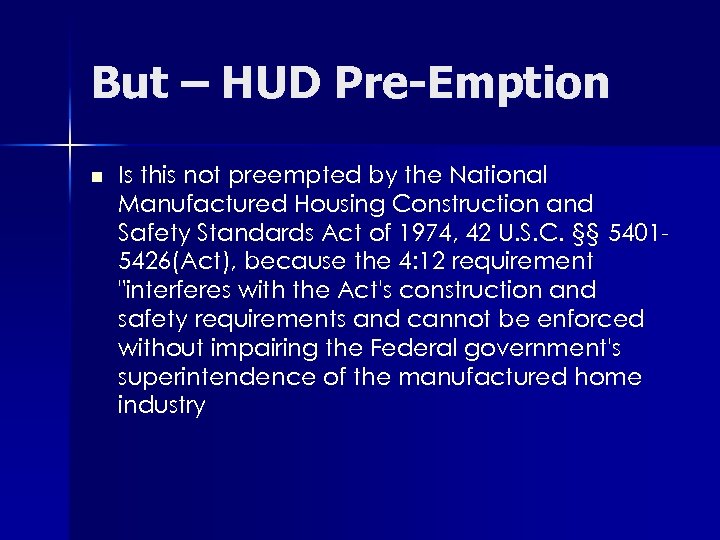 But – HUD Pre-Emption n Is this not preempted by the National Manufactured Housing Construction and Safety Standards Act of 1974, 42 U. S. C. §§ 54015426(Act), because the 4: 12 requirement "interferes with the Act's construction and safety requirements and cannot be enforced without impairing the Federal government's superintendence of the manufactured home industry
But – HUD Pre-Emption n Is this not preempted by the National Manufactured Housing Construction and Safety Standards Act of 1974, 42 U. S. C. §§ 54015426(Act), because the 4: 12 requirement "interferes with the Act's construction and safety requirements and cannot be enforced without impairing the Federal government's superintendence of the manufactured home industry
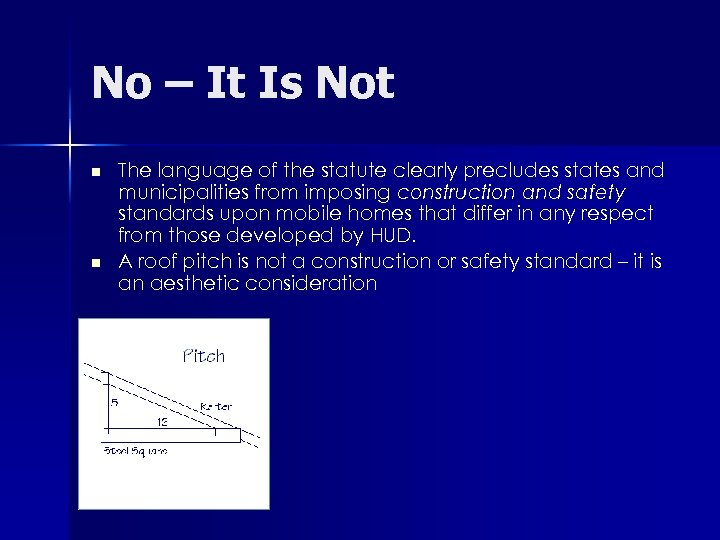 No – It Is Not n n The language of the statute clearly precludes states and municipalities from imposing construction and safety standards upon mobile homes that differ in any respect from those developed by HUD. A roof pitch is not a construction or safety standard – it is an aesthetic consideration
No – It Is Not n n The language of the statute clearly precludes states and municipalities from imposing construction and safety standards upon mobile homes that differ in any respect from those developed by HUD. A roof pitch is not a construction or safety standard – it is an aesthetic consideration
 Benefit of Signs and Advertising Devices n Information and Public Communication
Benefit of Signs and Advertising Devices n Information and Public Communication
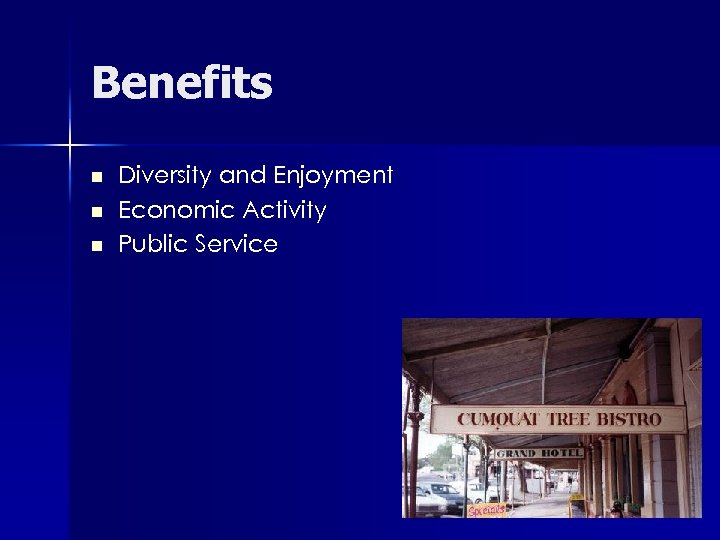 Benefits n n n Diversity and Enjoyment Economic Activity Public Service
Benefits n n n Diversity and Enjoyment Economic Activity Public Service
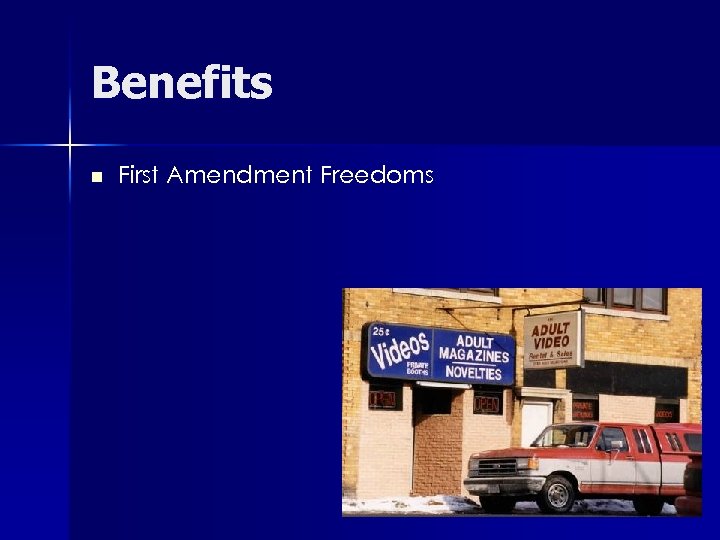 Benefits n First Amendment Freedoms
Benefits n First Amendment Freedoms
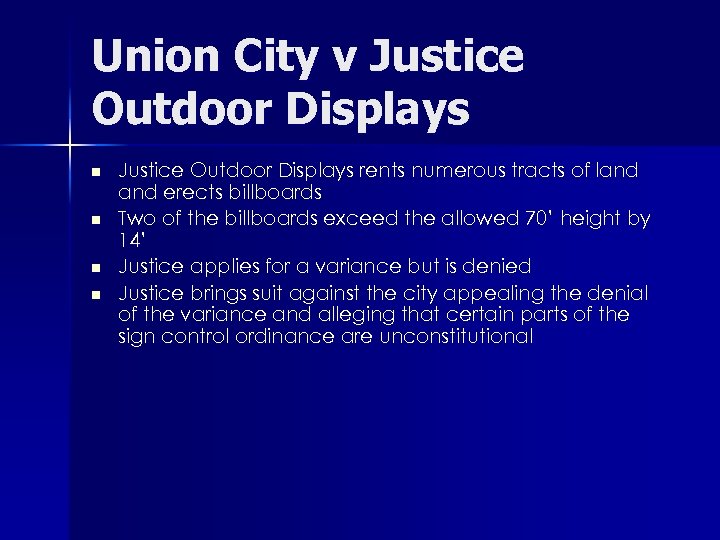 Union City v Justice Outdoor Displays n n Justice Outdoor Displays rents numerous tracts of land erects billboards Two of the billboards exceed the allowed 70’ height by 14’ Justice applies for a variance but is denied Justice brings suit against the city appealing the denial of the variance and alleging that certain parts of the sign control ordinance are unconstitutional
Union City v Justice Outdoor Displays n n Justice Outdoor Displays rents numerous tracts of land erects billboards Two of the billboards exceed the allowed 70’ height by 14’ Justice applies for a variance but is denied Justice brings suit against the city appealing the denial of the variance and alleging that certain parts of the sign control ordinance are unconstitutional
 First Court Trial n The trial court upholds the city’s denial of the variance but rules that certain parts of the ordinance are unconstitutional – The ordinances favors some signs based on the content of their messages – The ordinance limits the use of political signs to certain zoning districts for a limited period of time – The ordinance discriminates in favor of signs for schools, libraries, and other quasi-governmental agencies
First Court Trial n The trial court upholds the city’s denial of the variance but rules that certain parts of the ordinance are unconstitutional – The ordinances favors some signs based on the content of their messages – The ordinance limits the use of political signs to certain zoning districts for a limited period of time – The ordinance discriminates in favor of signs for schools, libraries, and other quasi-governmental agencies
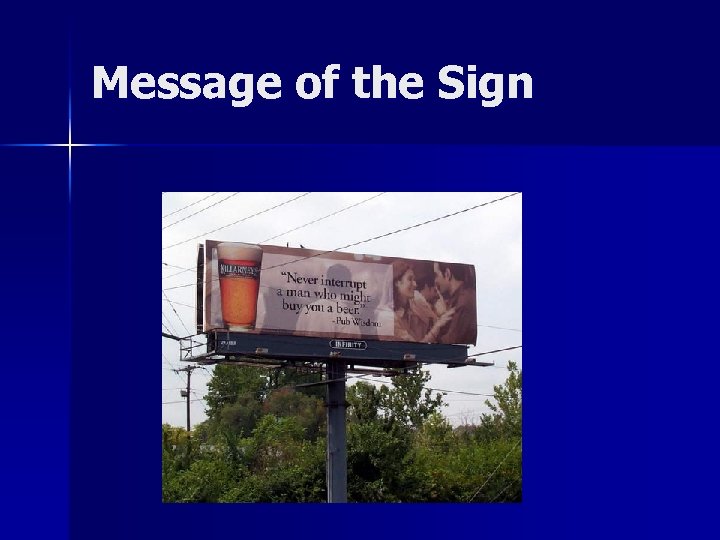 Message of the Sign
Message of the Sign
 Appeals Court Review n This is the major concern with the ordinance: – All signs are classified as either on-site, off-site, or temporary – If the sign is on-site, it must contain a commercial message – non-commercial messages are not allowed – In other words, the ordinance limits on-premise signs to messages advertising a product, person, service, place, activity, event, or idea directly connected with the property, it effectively bans signs bearing noncommercial messages in zoning districts where a sign of the same size and structure may display commercial advertisements.
Appeals Court Review n This is the major concern with the ordinance: – All signs are classified as either on-site, off-site, or temporary – If the sign is on-site, it must contain a commercial message – non-commercial messages are not allowed – In other words, the ordinance limits on-premise signs to messages advertising a product, person, service, place, activity, event, or idea directly connected with the property, it effectively bans signs bearing noncommercial messages in zoning districts where a sign of the same size and structure may display commercial advertisements.
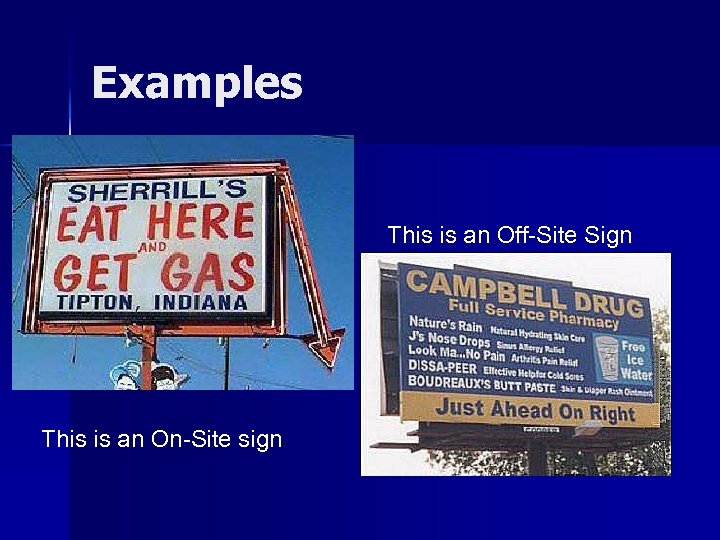 Examples This is an Off-Site Sign This is an On-Site sign
Examples This is an Off-Site Sign This is an On-Site sign
 Examples This on-site sign complies with the ordinance This sign does has no commercial message and does not comply
Examples This on-site sign complies with the ordinance This sign does has no commercial message and does not comply
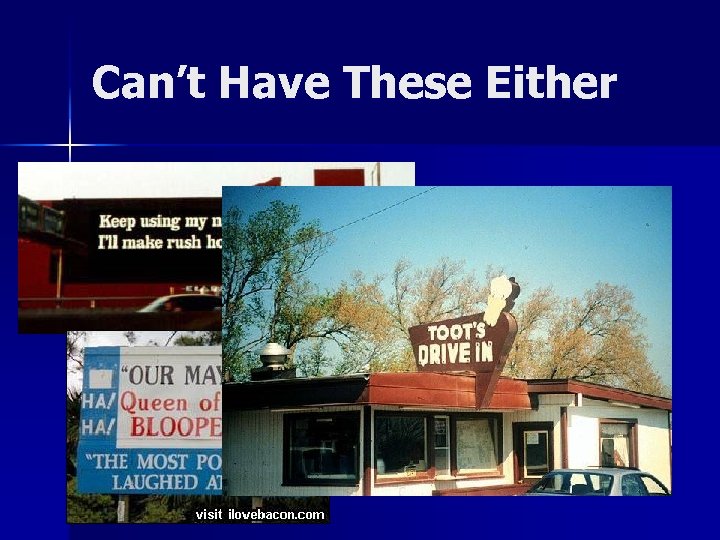 Can’t Have These Either
Can’t Have These Either
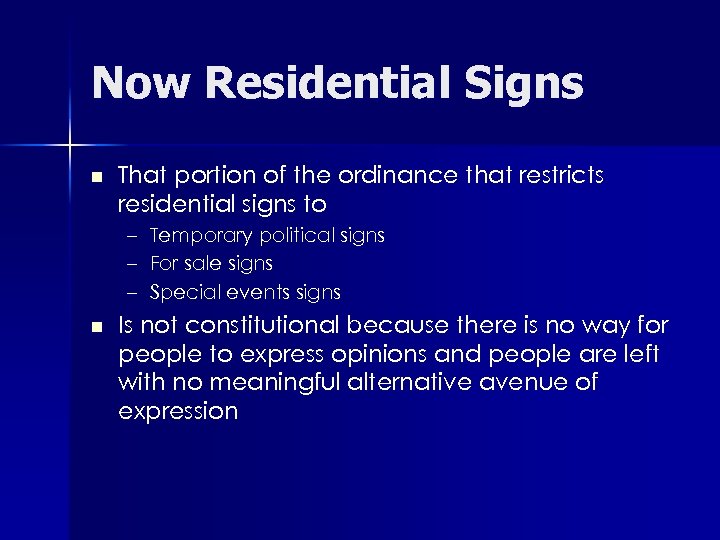 Now Residential Signs n That portion of the ordinance that restricts residential signs to – – – n Temporary political signs For sale signs Special events signs Is not constitutional because there is no way for people to express opinions and people are left with no meaningful alternative avenue of expression
Now Residential Signs n That portion of the ordinance that restricts residential signs to – – – n Temporary political signs For sale signs Special events signs Is not constitutional because there is no way for people to express opinions and people are left with no meaningful alternative avenue of expression
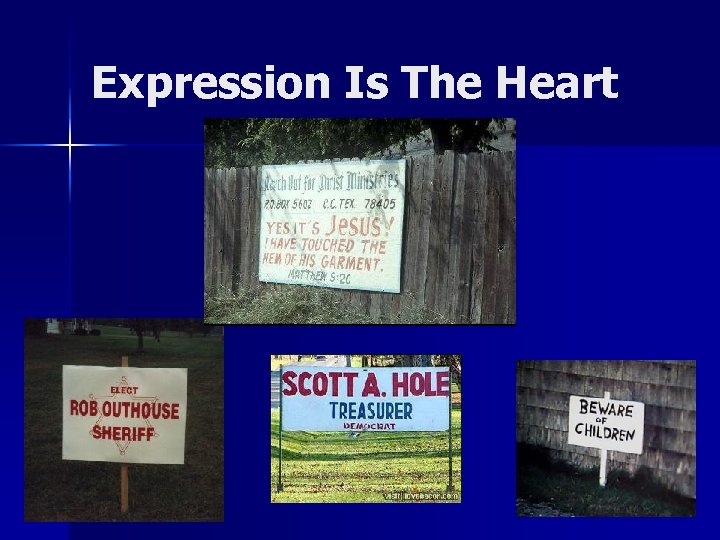 Expression Is The Heart
Expression Is The Heart
 Of The 1 st Amendment
Of The 1 st Amendment
 But What About Justice Outdoor? n n The prohibition against off-site billboards greater than 70 feet in height is a time, manner, place restriction These types of restrictions do not discriminate based upon the content of the message and thus are reasonable unless the complaining party can show, by a preponderance of evidence, that they are arbitrary and capricious
But What About Justice Outdoor? n n The prohibition against off-site billboards greater than 70 feet in height is a time, manner, place restriction These types of restrictions do not discriminate based upon the content of the message and thus are reasonable unless the complaining party can show, by a preponderance of evidence, that they are arbitrary and capricious
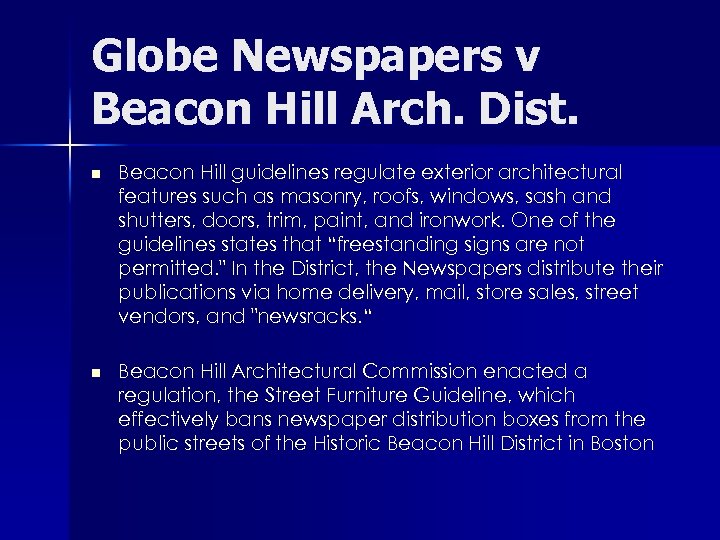 Globe Newspapers v Beacon Hill Arch. Dist. n Beacon Hill guidelines regulate exterior architectural features such as masonry, roofs, windows, sash and shutters, doors, trim, paint, and ironwork. One of the guidelines states that “freestanding signs are not permitted. " In the District, the Newspapers distribute their publications via home delivery, mail, store sales, street vendors, and "newsracks. “ n Beacon Hill Architectural Commission enacted a regulation, the Street Furniture Guideline, which effectively bans newspaper distribution boxes from the public streets of the Historic Beacon Hill District in Boston
Globe Newspapers v Beacon Hill Arch. Dist. n Beacon Hill guidelines regulate exterior architectural features such as masonry, roofs, windows, sash and shutters, doors, trim, paint, and ironwork. One of the guidelines states that “freestanding signs are not permitted. " In the District, the Newspapers distribute their publications via home delivery, mail, store sales, street vendors, and "newsracks. “ n Beacon Hill Architectural Commission enacted a regulation, the Street Furniture Guideline, which effectively bans newspaper distribution boxes from the public streets of the Historic Beacon Hill District in Boston
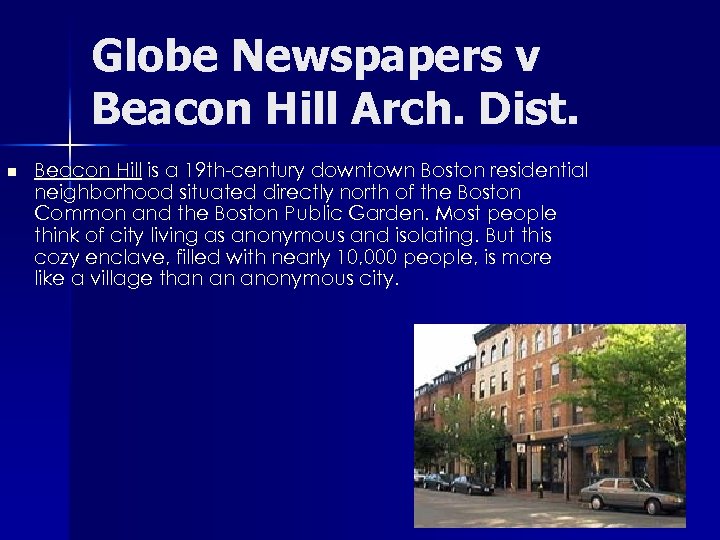 Globe Newspapers v Beacon Hill Arch. Dist. n Beacon Hill is a 19 th-century downtown Boston residential neighborhood situated directly north of the Boston Common and the Boston Public Garden. Most people think of city living as anonymous and isolating. But this cozy enclave, filled with nearly 10, 000 people, is more like a village than an anonymous city.
Globe Newspapers v Beacon Hill Arch. Dist. n Beacon Hill is a 19 th-century downtown Boston residential neighborhood situated directly north of the Boston Common and the Boston Public Garden. Most people think of city living as anonymous and isolating. But this cozy enclave, filled with nearly 10, 000 people, is more like a village than an anonymous city.
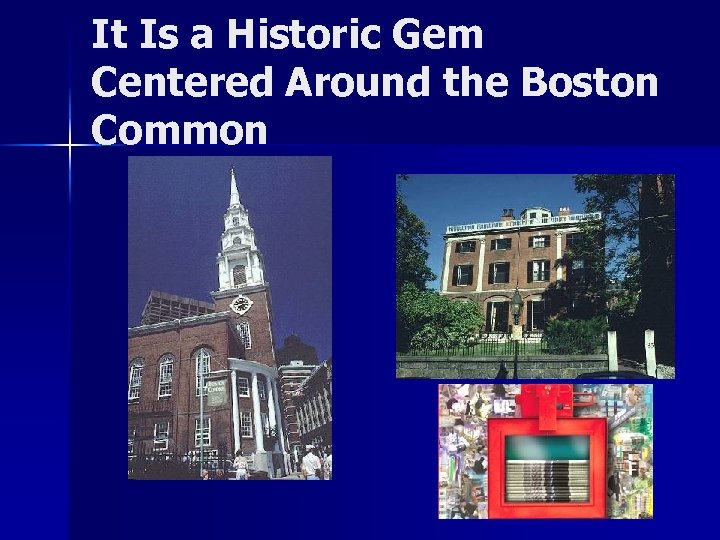 It Is a Historic Gem Centered Around the Boston Common
It Is a Historic Gem Centered Around the Boston Common
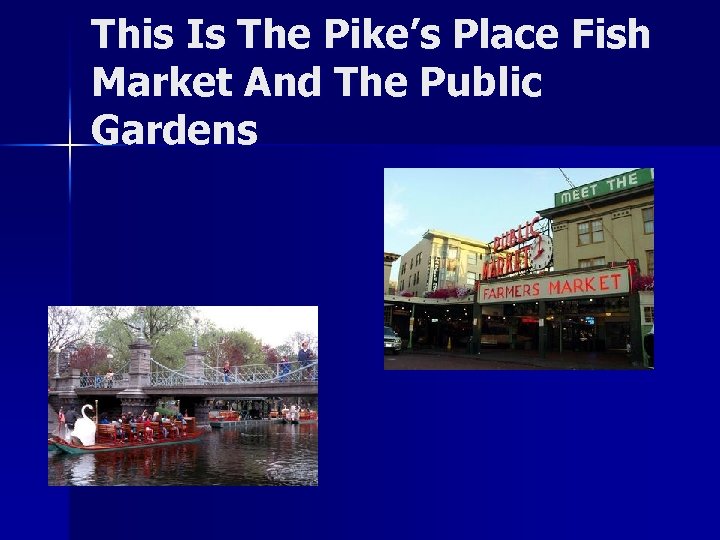 This Is The Pike’s Place Fish Market And The Public Gardens
This Is The Pike’s Place Fish Market And The Public Gardens
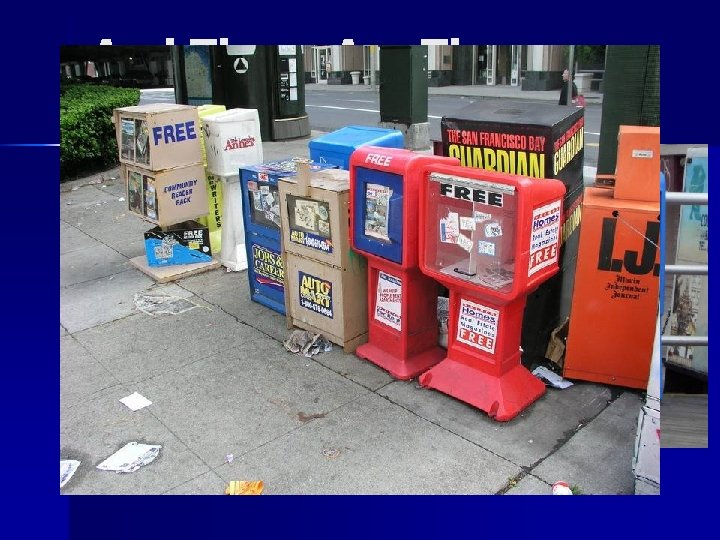 And These Are The Newsracks
And These Are The Newsracks
 District Court Ruling n n n After the bench ruling in the trial case, but before judgment had entered, the Commission adopted a new guideline -- the present Street Furniture Guideline -- that bans all "street furniture, " not just newsracks, from the District Several publishers content that the ban is a form of censorship – because publications that rely on newsracks are at a disadvantage Court rules against the regulations
District Court Ruling n n n After the bench ruling in the trial case, but before judgment had entered, the Commission adopted a new guideline -- the present Street Furniture Guideline -- that bans all "street furniture, " not just newsracks, from the District Several publishers content that the ban is a form of censorship – because publications that rely on newsracks are at a disadvantage Court rules against the regulations
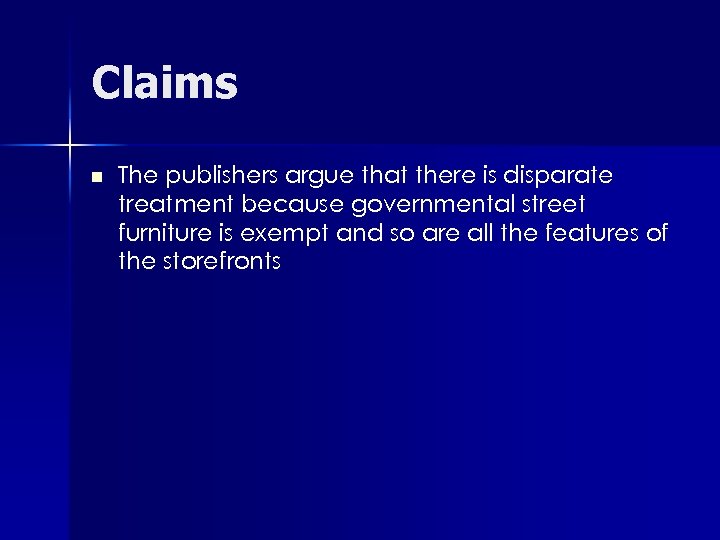 Claims n The publishers argue that there is disparate treatment because governmental street furniture is exempt and so are all the features of the storefronts
Claims n The publishers argue that there is disparate treatment because governmental street furniture is exempt and so are all the features of the storefronts
 Conclusion n As we see it, the Newspapers' complaint boils down to the potential reader passing through the District or the non-subscribing resident and, as we discuss later, ample alternative channels exist for the Newspapers to reach even these accidental transients passing through the District as well as those readers with more frequent ties to the District
Conclusion n As we see it, the Newspapers' complaint boils down to the potential reader passing through the District or the non-subscribing resident and, as we discuss later, ample alternative channels exist for the Newspapers to reach even these accidental transients passing through the District as well as those readers with more frequent ties to the District
 Review of Points Regulation must be content neutral Aesthetics – A Significant Governmental Interest Narrowly Tailored – Limits Speech No More Than Necessary Does it Leave Ample Alternative Channels
Review of Points Regulation must be content neutral Aesthetics – A Significant Governmental Interest Narrowly Tailored – Limits Speech No More Than Necessary Does it Leave Ample Alternative Channels
